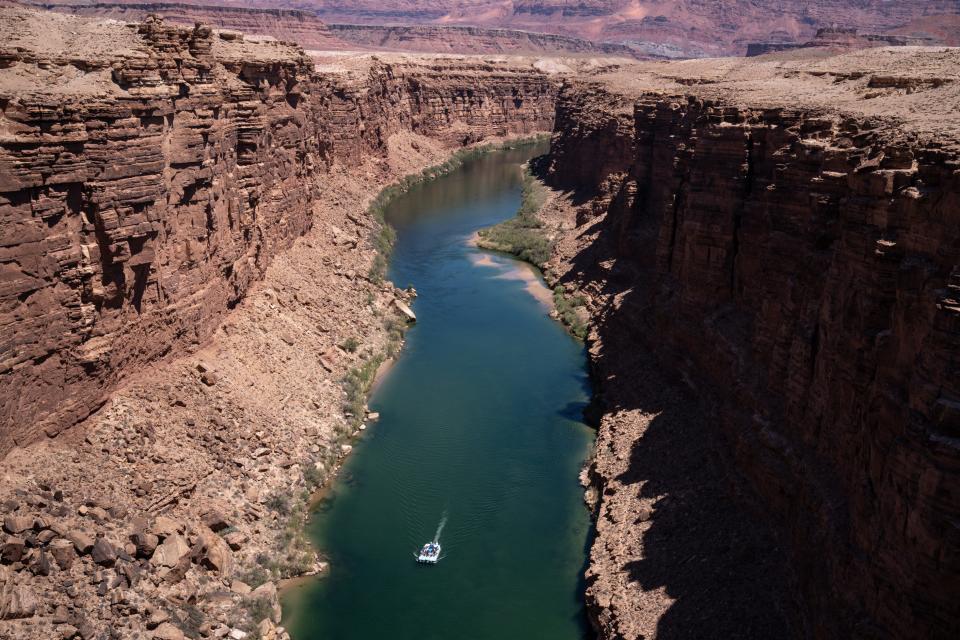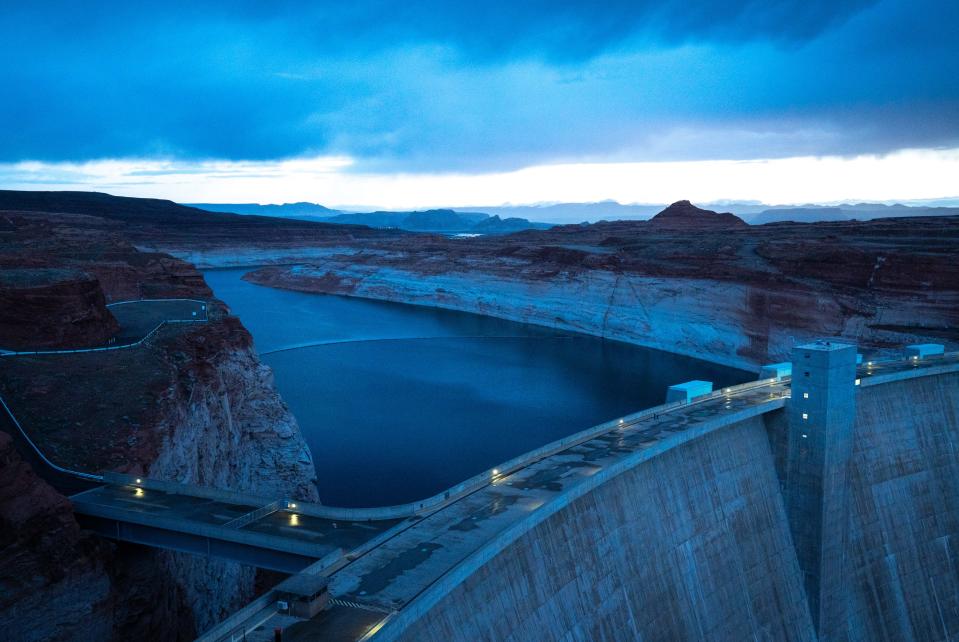Grand Canyon flood experiment helped restore beaches, delighting Colorado River runners
Grand Canyon river runners enjoyed the best camping beaches in years this season, and a riverside vegetation restoration project got a boost, both the result of the first planned springtime flood on the Colorado River since 2008.
The Bureau of Reclamation opened the bypass tubes at Glen Canyon Dam in April to unleash 40,000 cubic feet of water per second for 79 hours, more than doubling peak flow from previous days. It’s part of an environmental mitigation program that began in the 1990s after passage of the federal Grand Canyon Protection Act, with the aim of occasionally churning up sand from the riverbed to restore sandbars and beaches that the pre-dam river would have remade naturally with annual floods.
The water moved 830,000 tons of sediment out of the Lees Ferry area, where boaters put in for Grand Canyon trips, and it heaped new deposits on 85% of the beaches that the U.S. Geological Survey monitors by camera, officials said. That sand stacked up on downstream beaches.
Some of the gains eroded later in the summer, as the government needed to send water downstream to Lake Mead, but most beaches still maintained a net gain on the year, Grand Canyon Monitoring and Research Center hydrologist Paul Grams reported to a technical work group advising Reclamation on dam operations.

The mounded beaches and associated sand drifts are where thousands of river runners each year secure their boats and pitch tents or cots for the night. Low water behind the dam in Lake Powell had made it difficult to schedule a flood until this year’s ample snowmelt and the government had not approved one since the fall of 2018. Several years of erosion, compounded by two big monsoon rain seasons, had carved gullies in what remained.
This year, river guides stayed happy all summer, said Ben Reeder, who represents guides on the technical work group. He took his last trip of the season in September and said the benefits remained clear.
“There was a huge benefit and a huge boost to the canyon, to the camping beaches, to the river experience,” Reeder said. “We’re super grateful to all the folks who worked so hard to get that done.”
Before-and-after photos of various beaches and sandbars from this and previous flood events are available online at usgs.gov/apps/sandbar/.
A survey of river guides found that 97% believe the flood produced big ecological benefits and 95% saw recreational benefits. A springtime flood, as opposed to the fall floods that officials have more often approved, mimics the natural runoff season and maximizes gains just before the float-trip season, Reeder said.
A river's environment: To keep the Colorado River's heart beating, people step in to do what nature once did
And one thing more: “There were a lot less ants in camp,” he said. Float groups in the national park are asked to spread tarps on the sand when they prepare food, but scraps and crumbs may accumulate and attract pests. “It seemed like it was a good cleanse for the canyon, (and) really needed.”
The flood also helped the Grand Canyon Wildlands Council in its effort to restore native trees and plants at Paria Beach, just downstream of where river runners launch. The flood watered newly planted cottonwoods without uprooting them, Council Executive Director Kelly Burke said.
“It was perfectly timed for having really nice growth on those trees.”
Just as the dam's construction altered Grand Canyon’s flow of sand, it dramatically altered the vegetation. Native cottonwoods and willows were largely replaced by non-native tamarisks, also known as salt cedar. If successful, Burke said, the restoration could be repeated through the canyon.

These floods also come with costs, generally in the millions of dollars in lost hydroelectric production due to water bypassing the power turbines. Lowering Lake Powell may also risk future power losses if drought keeps snowfall in the mountains from replenishing the floodwater.
That water is not lost to downstream farmers and residents, as it flows past the Grand Canyon and into Lake Mead for continued storage. A full accounting of both the costs and benefits is due in January with completion of the Glen Canyon Dam Adaptive Management Program’s annual report.
Relatively rapid erosion of beaches and sandbars has been the norm with these floods, which are generally spaced years apart. This year’s erosion was exacerbated by high summer flows that Reclamation had to maintain to transfer water to Lake Mead that it had previously held back to prevent water levels at Lake Powell from reaching critical lows. The result was that regularly scheduled summer flows moved more sand out of Lees Ferry than the flood did.
Erosion also rises with summer peaks in hydropower demand, which leads to big daily swings in releases. Those influences would have further eroded the already depleted beaches if there had been no flood, Grams said.
One negative side effect noted after the 2008 springtime flood does not appear to have recurred this year. Fifteen years ago, the flood appeared to supercharge the survival of young rainbow trout. While those non-native fish are popular with sport anglers, they present a risk to the threatened but growing population of native humpback chubs in the canyon.
Biologists tracking the trout population said there was no discernible bump in the population of young trout this year, possibly because this flood was later in the spring than the one in 2008, or because years of drought and warming water had changed conditions.
Brandon Loomis covers environmental and climate issues for The Arizona Republic and azcentral.com. Reach him at brandon.loomis@arizonarepublic.com or follow him on X, formerly known as Twitter, @brandonloomis.
Environmental coverage on azcentral.com and in The Arizona Republic is supported by a grant from the Nina Mason Pulliam Charitable Trust. Sign up for AZ Climate, our weekly environment newsletter, and follow The Republic environmental reporting team at environment.azcentral.com and @azcenvironment on Facebook, Twitter and Instagram.
You can support environmental journalism in Arizona by subscribing to azcentral.com today.
This article originally appeared on Arizona Republic: A flood from Glen Canyon Dam temporarily lifts Grand Canyon beaches

